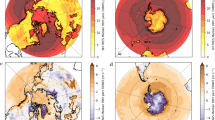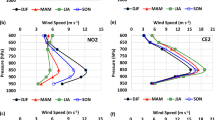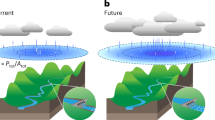Abstract
Straight line winds (SLWs), or non-tornadic thunderstorm winds, are causing widespread damage in many regions around the world. These powerful gusts are associated with strong downdraughts in thunderstorms, rear inflow jets and mesovortices. Despite their significance, our understanding of climate change effects on SLWs remains limited. Here, focusing on the central USA, a global hot spot for SLWs, I use observations, high-resolution modelling and theoretical considerations to show that SLWs have intensified over the past 40 years. Theoretical considerations suggest that SLWs should intensify at a rate of ~7.5% °C−1, yet the observed rates show a more pronounced increase of ~13% °C−1. The simulation results indicate a 4.8 ± 1.2-fold increase in the geographical extent affected by SLWs during the study period. These findings underscore the importance of incorporating intensifying SLWs into climate change adaptation planning to ensure the development of resilient future infrastructure.
This is a preview of subscription content, access via your institution
Access options
Access Nature and 54 other Nature Portfolio journals
Get Nature+, our best-value online-access subscription
$29.99 / 30 days
cancel any time
Subscribe to this journal
Receive 12 print issues and online access
$209.00 per year
only $17.42 per issue
Buy this article
- Purchase on Springer Link
- Instant access to full article PDF
Prices may be subject to local taxes which are calculated during checkout





Similar content being viewed by others
Data availability
The HadISD dataset is available from https://www.metoffice.gov.uk/hadobs/hadisd/, the ASOS data from https://www.ncei.noaa.gov/products/land-based-station/automated-surface-weather-observing-systems, the GridSat data are accessible from https://www.ncdc.noaa.gov/gridsat/, the ERA5 reanalysis is available from https://cds.climate.copernicus.eu/cdsapp#!/dataset/reanalysis-era5-single-levels and the C-404 output can be accessed from https://rda.ucar.edu/datasets/ds559.0/ ref. 93.
Code availability
The code for the statistical analysis and visualization of data in this document can be accessed from https://github.com/AndreasPrein/Thunderstorm_Downbursts_Climate_Change ref. 85.
References
Solari, G. Thunderstorm downbursts and wind loading of structures: progress and prospect. Front. Built Environ. 6, 63 (2020).
Lu, N.-Y., Hawbecker, P., Basu, S. & Manuel, L. On wind turbine loads during thunderstorm downbursts in contrasting atmospheric stability regimes. Energies 12, 2773 (2019).
Oliver, S., Moriarty, W. & Holmes, J. A risk model for design of transmission line systems against thunderstorm downburst winds. Eng. Struct. 22, 1173–1179 (2000).
Fortuin, C. C., Montes, C. R., Vogt, J. T. & Gandhi, K. J. Predicting risks of tornado and severe thunderstorm damage to southeastern US forests. Landsc. Ecol. 37, 1905–1919 (2022).
Ashley, W. S. & Mote, T. L. Derecho hazards in the United States. Bull. Am. Meteorol. Soc. 86, 1577–1592 (2005).
Pacey, G. P., Schultz, D. M. & Garcia-Carreras, L. Severe convective windstorms in Europe: climatology, preconvective environments, and convective mode. Weather Forecast. 36, 237–252 (2021).
Brown, A. & Dowdy, A. Severe convection-related winds in Australia and their associated environments. J. South. Hemisph. Earth Syst. Sci. 71, 30–52 (2021).
Gensini, V. A., Haberlie, A. M. & Marsh, P. T. Practically perfect hindcasts of severe convective storms. Bull. Am. Meteorol. Soc. 101, E1259–E1278 (2020).
Lombardo, F. T. & Zickar, A. S. Characteristics of measured extreme thunderstorm near-surface wind gusts in the United States. J. Wind Eng. Ind. Aerodyn. 193, 103961 (2019).
Trapp, R. J., Wheatley, D. M., Atkins, N. T., Przybylinski, R. W. & Wolf, R. Buyer beware: some words of caution on the use of severe wind reports in postevent assessment and research. Weather Forecast. 21, 408–415 (2006).
Edwards, R., Allen, J. T. & Carbin, G. W. Reliability and climatological impacts of convective wind estimations. J. Appl. Meteorol. Climatol. 57, 1825–1845 (2018).
Taszarek, M. et al. Severe convective storms across Europe and the United States. Part I: Climatology of lightning, large hail, severe wind, and tornadoes. J. Clim. 33, 10239–10261 (2020).
Corfidi, S. F., Coniglio, M. C., Cohen, A. E. & Mead, C. M. A proposed revision to the definition of “derecho". Bull. Am. Meteorol. Soc. 97, 935–949 (2016).
Wakimoto, R. M. & Bringi, V. Dual-polarization observations of microbursts associated with intense convection: the 20 July storm during the MIST project. Mon. Weather Rev. 116, 1521–1539 (1988).
Fujita, T. T. Tornadoes and downbursts in the context of generalized planetary scales. J. Atmos. Sci. 38, 1511–1534 (1981).
Wakimoto, R. M. Forecasting dry microburst activity over the high plains. Mon. Weather Rev. 113, 1131–1143 (1985).
Johns, R. H. & Hirt, W. D. Derechos: widespread convectively induced windstorms. Weather Forecast. 2, 32–49 (1987).
Evans, J. S. & Doswell, C. A. Examination of derecho environments using proximity soundings. Weather Forecast. 16, 329–342 (2001).
Romanic, D., Taszarek, M. & Brooks, H. Convective environments leading to microburst, macroburst and downburst events across the United States. Weather Clim. Extremes 37, 100474 (2022).
Johns, R. H. & Doswell, C. A. III Severe local storms forecasting. Weather Forecast. 7, 588–612 (1992).
Browning, K. A. & Ludlam, F. H. Airflow in convective storms. Q. J. R. Meteorol. Soc. 88, 117–135 (1962).
Hookings, G. Precipitation-maintained downdrafts. J. Appl. Meteorol. Climatol. 4, 190–195 (1965).
Prein, A. F. et al. Increased rainfall volume from future convective storms in the US. Nat. Clim. Change 7, 880–884 (2017).
Hoogewind, K. A., Baldwin, M. E. & Trapp, R. J. The impact of climate change on hazardous convective weather in the United States: insight from high-resolution dynamical downscaling. J. Clim. 30, 10081–10100 (2017).
Trapp, R. J., Hoogewind, K. A. & Lasher-Trapp, S. Future changes in hail occurrence in the United States determined through convection-permitting dynamical downscaling. J. Clim. 32, 5493–5509 (2019).
Haberlie, A. M., Ashley, W. S., Battisto, C. M. & Gensini, V. A. Thunderstorm activity under intermediate and extreme climate change scenarios. Geophys. Res. Lett. 49, e2022GL098779 (2022).
Ashley, W. S., Haberlie, A. M. & Gensini, V. A. The future of supercells in the United States. Bull. Am. Meteorol. Soc. 104, E1–E21 (2023).
Trenberth, K. E. Changes in precipitation with climate change. Clim. Res. 47, 123–138 (2011).
Rasmussen, K. L., Prein, A. F., Rasmussen, R. M., Ikeda, K. & Liu, C. Changes in the convective population and thermodynamic environments in convection-permitting regional climate simulations over the United States. Clim. Dyn. 55, 383–408 (2020).
Chen, J., Dai, A., Zhang, Y. & Rasmussen, K. L. Changes in convective available potential energy and convective inhibition under global warming. J. Clim. 33, 2025–2050 (2020).
Done, J. M., Lackmann, G. M. & Prein, A. F. The response of tropical cyclone intensity to changes in environmental temperature. Weather Clim. Dyn. 3, 693–711 (2022).
Brooks, H. E. Severe thunderstorms and climate change. Atmos. Res. 123, 129–138 (2013).
National Academies of Sciences, Engineering, and Medicine Attribution of Extreme Weather Events in the Context of Climate Change (National Academies Press, 2016).
Dunn, R. J. et al. HadISD: a quality-controlled global synoptic report database for selected variables at long-term stations from 1973–2011. Climate 8, 1649–1679 (2012).
Dunn, R. J. et al. Reduction in reversal of global stilling arising from correction to encoding of calm periods. Environ. Res. Commun. 4, 061003 (2022).
Rasmussen, R. M. et al. The NCAR/USGS 4-km long-term regional hydroclimate re-analysis over the CONUS. Bull. Am. Meteorol. Soc. 104 (2023).
Wang, D., Giangrande, S. E., Feng, Z., Hardin, J. C. & Prein, A. F. Updraft and downdraft core size and intensity as revealed by radar wind profilers: MCS observations and idealized model comparisons. J. Geophys. Res. Atmos. 125, e2019JD031774 (2020).
Prein, A., Rasmussen, R., Wang, D. & Giangrande, S. Sensitivity of organized convective storms to model grid spacing in current and future climates. Phil. Trans. R. Soc. A 379, 20190546 (2021).
Morrison, H. et al. Confronting the challenge of modeling cloud and precipitation microphysics. J. Adv. Model. Earth Syst. 12, e2019MS001689 (2020).
Weisman, M. L., Skamarock, W. C. & Klemp, J. B. The resolution dependence of explicitly modeled convective systems. Mon. Weather Rev. 125, 527–548 (1997).
Prein, A. F. et al. A review on regional convection-permitting climate modeling: demonstrations, prospects, and challenges. Rev. Geophys. 53, 323–361 (2015).
Fujita, T. T. & Byers, H. R. Spearhead echo and downburst in the crash of an airliner. Mon. Weather Rev. 105, 129–146 (1977).
Hersbach, H. et al. The ERA5 global reanalysis. Q. J. R. Meteorol. Soc. 146, 1999–2049 (2020).
Skamarock, W. C. & Klemp, J. B. A time-split nonhydrostatic atmospheric model for weather research and forecasting applications. J. Comput. Phys. 227, 3465–3485 (2008).
Powers, J. G. et al. The weather research and forecasting model: overview, system efforts, and future directions. Bull. Am. Meteorol. Soc. 98, 1717–1737 (2017).
Skamarock, W. C. Evaluating mesoscale NWP models using kinetic energy spectra. Mon. Weather Rev. 132, 3019–3032 (2004).
El Rafei, M., Sherwood, S., Evans, J. P. & Ji, F. Analysis of extreme wind gusts using a high-resolution Australian regional reanalysis. Weather Clim. Extremes 39, 100537 (2023).
Vautard, R., Cattiaux, J., Yiou, P., Thépaut, J.-N. & Ciais, P. Northern Hemisphere atmospheric stilling partly attributed to an increase in surface roughness. Nat. Geosci. 3, 756–761 (2010).
Brooks, H. E., Lee, J. W. & Craven, J. P. The spatial distribution of severe thunderstorm and tornado environments from global reanalysis data. Atmos. Res. 67, 73–94 (2003).
Sherburn, K. D., Parker, M. D., King, J. R. & Lackmann, G. M. Composite environments of severe and nonsevere high-shear, low-CAPE convective events. Weather Forecast. 31, 1899–1927 (2016).
Moncrieff, M. W. & Miller, M. J. The dynamics and simulation of tropical cumulonimbus and squall lines. Q. J. R. Meteorol. Soc. 102, 373–394 (1976).
Markowski, P. & Richardson, Y. Mesoscale Meteorology in Midlatitudes (John Wiley & Sons, 2011).
Emanuel, K. A. et al. Atmospheric convection (Oxford Univ. Press, 1994).
Gilmore, M. S. & Wicker, L. J. The influence of midtropospheric dryness on supercell morphology and evolution. Mon. Weather Rev. 126, 943–958 (1998).
Bryan, G. H. & Parker, M. D. Observations of a squall line and its near environment using high-frequency rawinsonde launches during VORTEX2. Mon. Weather Rev. 138, 4076–4097 (2010).
Rotunno, R., Klemp, J. B. & Weisman, M. L. A theory for strong, long-lived squall lines. J. Atmos. Sci. 45, 463–485 (1988).
Atkins, N. T. & St. Laurent, M. Bow echo mesovortices. Part I: Processes that influence their damaging potential. Mon. Weather Rev. 137, 1497–1513 (2009).
Deser, C., Phillips, A., Bourdette, V. & Teng, H. Uncertainty in climate change projections: the role of internal variability. Clim. Dyn. 38, 527–546 (2012).
Ghil, M. & Lucarini, V. The physics of climate variability and climate change. Rev. Mod. Phys. 92, 035002 (2020).
Doswell, C. A. III & Evans, J. S. Proximity sounding analysis for derechos and supercells: an assessment of similarities and differences. Atmos. Res. 67, 117–133 (2003).
Masson-Delmotte, V. et al. IPCC Climate Change 2021: The Physical Science Basis (Cambridge Univ. Press, 2021).
O’Gorman, P. A. & Schneider, T. The physical basis for increases in precipitation extremes in simulations of 21st-century climate change. Proc. Natl Acad. Sci. USA 106, 14773–14777 (2009).
Clausius, R. Ueber die bewegende Kraft der Wärme und die Gesetze, welche sich daraus für die Wärmelehre selbst ableiten lassen. Ann. der Phys. 155, 368–397 (1850).
Wuebbles, D. et al. Climate Science Special Report: Fourth National Climate Assessment (NCA4) Vol. I (2017).
Fujita, T. T. Manual of Downburst Identification for Project NIMROD (1978).
Atkins, N. T., Bouchard, C. S., Przybylinski, R. W., Trapp, R. J. & Schmocker, G. Damaging surface wind mechanisms within the 10 June 2003 Saint Louis bow echo during BAMEX. Mon. Weather Rev. 133, 2275–2296 (2005).
Prein, A. F. & Heymsfield, A. J. Increased melting level height impacts surface precipitation phase and intensity. Nat. Clim. Change 10, 771–776 (2020).
Shepherd, T. G. Atmospheric circulation as a source of uncertainty in climate change projections. Nat. Geosci. 7, 703–708 (2014).
Shepherd, T. G. Storyline approach to the construction of regional climate change information. Proc. R. Soc. A 475, 20190013 (2019).
Federal Meteorological Handbook No. 1: Surface Weather Observations and Reports (NOAA, 2019); https://www.icams-portal.gov/resources/ofcm/fmh/FMH1/fmh1_2019.pdf
Dunn, R., Willett, K., Morice, C. & Parker, D. Pairwise homogeneity assessment of HadISD. Climate 10, 1501–1522 (2014).
Guide to Instruments and Methods of Observation (WMO, 2018); https://library.wmo.int/index.php
Ramon, J., Lledó, L., Torralba, V., Soret, A. & Doblas-Reyes, F. J. What global reanalysis best represents near-surface winds? Q. J. R. Meteorol. Soc. 145, 3236–3251 (2019).
Olauson, J. ERA5: the new champion of wind power modelling? Renew. Energy 126, 322–331 (2018).
Molina, M. O., Gutiérrez, C. & Sánchez, E. Comparison of ERA5 surface wind speed climatologies over Europe with observations from the HadISD dataset. Int. J. Climatol. 41, 4864–4878 (2021).
Liu, C. et al. Continental-scale convection-permitting modeling of the current and future climate of North America. Clim. Dyn. 49, 71–95 (2017).
Barlage, M., Chen, F., Rasmussen, R., Zhang, Z. & Miguez-Macho, G. The importance of scale-dependent groundwater processes in land–atmosphere interactions over the central United States. Geophys. Res. Lett. 48, e2020GL092171 (2021).
Thompson, G., Field, P. R., Rasmussen, R. M. & Hall, W. D. Explicit forecasts of winter precipitation using an improved bulk microphysics scheme. Part II: Implementation of a new snow parameterization. Mon. Weather Rev. 136, 5095–5115 (2008).
Hong, S.-Y., Noh, Y. & Dudhia, J. A new vertical diffusion package with an explicit treatment of entrainment processes. Mon. Weather Rev. 134, 2318–2341 (2006).
Niu, G.-Y. et al. The community Noah land surface model with multiparameterization options (Noah-MP): 1. Model description and evaluation with local-scale measurements. J. Geophys. Res. Atmos. 116 (2011).
Yang, Z.-L. et al. The community Noah land surface model with multiparameterization options (Noah-MP): 2. Evaluation over global river basins. J. Geophys. Res. Atmos. 116 (2011).
Fan, Y., Miguez-Macho, G., Weaver, C. P., Walko, R. & Robock, A. Incorporating water table dynamics in climate modeling: 1. Water table observations and equilibrium water table simulations. J. Geophys. Res. Atmos. 112 (2007).
Iacono, M. J. et al. Radiative forcing by long-lived greenhouse gases: calculations with the AER radiative transfer models. J. Geophys. Res. Atmos. 113 (2008).
von Storch, H., Langenberg, H. & Feser, F. A spectral nudging technique for dynamical downscaling purposes. Mon. Weather Rev. 128, 3664–3673 (2000).
Pein, A. F. AndreasPrein/Thunderstorm_Downbursts_Climate_Change: V1.0. Zenodo https://doi.org/10.5281/zenodo.7688306 (2023).
wrf-python https://wrf-python.readthedocs.io/en/latest/ (WRF-Python Development Team, 2023).
Kastman, J., Market, P. & Fox, N. Dynamic ensemble analysis of frontal placement impacts in the presence of elevated thunderstorms during PRECIP events. Atmosphere 9, 339 (2018).
Tompkins, A. M. Organization of tropical convection in low vertical wind shears: the role of cold pools. J. Atmos. Sci. 58, 1650–1672 (2001).
Feng, Z. et al. Mechanisms of convective cloud organization by cold pools over tropical warm ocean during the AMIE/DYNAMO field campaign. J. Adv. Model. Earth Syst. 7, 357–381 (2015).
Feng, Z. et al. A global high-resolution mesoscale convective system database using satellite-derived cloud tops, surface precipitation, and tracking. J. Geophys. Res. Atmos. 126, e2020JD034202 (2021).
Wu, X. & Yan, J. Estimating the outgoing longwave radiation from the FY-3B satellite visible infrared radiometer Channel 5 radiance observations. Chin. Sci. Bull. 56, 3480–3485 (2011).
Knapp, K. R. et al. Globally gridded satellite observations for climate studies. Bull. Am. Meteorol. Soc. 92, 893–907 (2011).
Rasmussen, R. M. et al. Four-Kilometer Long-Term Regional Hydroclimate Reanalysis over the Conterminous United States (CONUS), 1979–2020 (NCAR, 2023); https://rda.ucar.edu/datasets/ds559.0/
Acknowledgements
I thank the US Geological Survey for providing computing resources on their Denali HPC system. I acknowledge high-performance computing support from Cheyenne (https://doi.org/10.5065/D6RX99HX) provided by NCAR’s Computational and Information Systems Laboratory. NCAR is sponsored by the National Science Foundation under Cooperative Agreement 1852977. I acknowledge support from the MIT Climate Grand Challenge on Weather and Climate Extremes. I also thank K. Ikeda and C. Liu for their efforts in creating the C-404 dataset.
Author information
Authors and Affiliations
Contributions
A.F.P. designed the study, collected the observational and modelling datasets, performed the analyses and wrote the manuscript.
Corresponding author
Ethics declarations
Competing interests
The author declares no competing interests.
Peer review
Peer review information
Nature Climate Change thanks Casey Burleyson and the other, anonymous, reviewer(s) for their contribution to the peer review of this work.
Additional information
Publisher’s note Springer Nature remains neutral with regard to jurisdictional claims in published maps and institutional affiliations.
Supplementary information
Supplementary Information
Supplementary Figs. 1–15.
Rights and permissions
Springer Nature or its licensor (e.g. a society or other partner) holds exclusive rights to this article under a publishing agreement with the author(s) or other rightsholder(s); author self-archiving of the accepted manuscript version of this article is solely governed by the terms of such publishing agreement and applicable law.
About this article
Cite this article
Prein, A.F. Thunderstorm straight line winds intensify with climate change. Nat. Clim. Chang. 13, 1353–1359 (2023). https://doi.org/10.1038/s41558-023-01852-9
Received:
Accepted:
Published:
Issue Date:
DOI: https://doi.org/10.1038/s41558-023-01852-9



